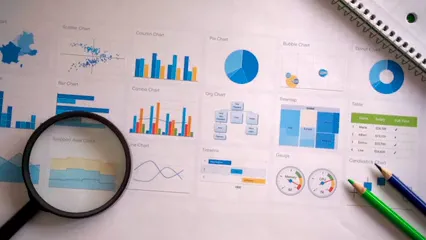Introduction
In a world overflowing with data, a statistics degree stands as a golden ticket. It arms graduates with the tools to extract meaning from the mountain of numbers surrounding us. From healthcare to finance, the importance of statistical analysis has never been more pronounced. Companies and organizations crave professionals who can transform raw data into actionable insights.
Speaking of transforming raw data, there’s a fantastic book that can help you strip the dread from the data—Naked Statistics: Stripping the Dread from the Data by Charles Wheelan. It’s a delightful read that makes statistics feel less like a foreign language and more like a fun puzzle to solve!
The Value of a Statistics Degree
Understanding the Skill Set
Earning a statistics degree equips you with some powerful skills. Data analysis, critical thinking, and problem-solving are just the tip of the iceberg. You’ll learn how to interpret complex datasets and draw meaningful conclusions. These quantitative skills are highly sought after across numerous industries. In finance, for instance, your ability to analyze risk can make or break investment decisions. In healthcare, your insights could help improve patient outcomes.
Moreover, teamwork and effective communication are crucial. Statisticians often work in teams, presenting their findings to stakeholders who may not have a statistical background. A knack for storytelling through data visualization can set you apart in this competitive field. The ability to convey intricate concepts in a digestible manner is invaluable.
If you want to develop your data visualization skills further, consider picking up The Art of Statistics: Learning from Data by David Spiegelhalter. This book will help you not just to analyze data, but also to present it like a pro!
Job Market Overview
The job market for statistics graduates is buzzing with opportunity. According to the Bureau of Labor Statistics, the demand for statisticians is projected to grow by an impressive 34% over the next decade. This growth rate is significantly higher than the average for all occupations. Industries are increasingly leaning on data-driven insights to inform their strategies, making statistical expertise more critical than ever.
From government agencies to private sectors, the need for data-savvy professionals is palpable. Whether you aim to work in pharmaceuticals, finance, or technology, the career prospects are bright. With a statistics degree, you’re not just equipped for a job; you’re set up for a fulfilling career that can adapt to the evolving landscape of the job market.
Statistics graduates are well-positioned to make a difference, armed with the skills and knowledge to tackle real-world problems. So, if you’re considering this path, rest assured that the future looks promising!

Career Paths for Statistics Graduates
Directly Related Careers
Statistician
Statisticians are the detectives of the data world. They collect, analyze, and interpret data to solve problems in various fields, including healthcare, finance, and marketing. Their job duties often include designing surveys and experiments, ensuring data quality, and reporting findings that can guide critical decision-making.
Statisticians typically work in diverse environments. You might find them in government agencies, research institutions, or private companies. Each setting offers unique challenges, from analyzing public health data to developing financial models.
The median salary for statisticians is around $96,280 per year, and the job outlook is impressive. With a projected growth rate of 34% over the next decade, the demand for statisticians is significantly higher than the average for all occupations. So, if you enjoy crunching numbers and uncovering insights, a career as a statistician might be your ticket to success.

Data Scientist
Data scientists are the superheroes of the statistics realm. They combine statistical knowledge with programming skills to analyze vast datasets. Their roles often involve using machine learning algorithms to extract meaningful patterns and insights. If you’re interested in diving deeper into data science, Data Science for Business by Foster Provost and Tom Fawcett is a must-read!
To thrive in this role, you’ll need a solid understanding of programming languages like Python or R, along with expertise in statistical modeling. Data scientists often work in tech companies, finance, or any industry that relies on data-driven decisions.
The median salary for data scientists is approximately $108,020, and the projected growth is a staggering 35% through 2032. With organizations increasingly turning to data for competitive advantage, this role is not just in demand; it’s a hot ticket!

Actuary
Actuaries are the financial risk managers of the world. They use mathematics and statistics to assess risk and uncertainty, primarily for insurance companies and pension funds. Actuaries analyze data to predict future events, helping organizations make informed decisions regarding policies and investments.
In this profession, you’ll tackle complex problems, often using advanced statistical techniques. Actuaries typically work in office environments, collaborating with other financial experts.
The median salary for actuaries stands at around $105,900, reflecting the high level of expertise required. With an estimated job growth rate of 18%, the demand for actuaries remains strong as companies seek ways to manage risks effectively.

Data Analyst
Data analysts are the interpreters of data. They transform raw numbers into actionable insights that businesses can use to improve operations. Job functions include collecting data, analyzing trends, and presenting findings in a clear, understandable format.
You’ll often find data analysts working in various industries, from healthcare to marketing. The skills required for this role include proficiency in statistical software and an understanding of data visualization tools.
The typical salary for data analysts is around $74,822 per year. The job outlook is positive, with a 25% growth rate projected through the next decade. As companies continue to rely on data for decision-making, the role of a data analyst will only become more critical.
In summary, a statistics degree opens the door to various exciting careers. Whether you choose to become a statistician, data scientist, actuary, or data analyst, the opportunities are abundant. With strong growth projections and competitive salaries, these roles promise a fulfilling career path for statistics graduates.

Careers Where a Statistics Degree is Useful
Financial Analyst
Financial analysts are the wizards of the finance world. They interpret data to guide investment decisions. With a statistics degree, you’re armed with essential skills to analyze market trends and assess risks. Your statistical prowess helps in evaluating financial statements, predicting future performance, and crafting sound investment strategies.
In this role, you’ll spend your days sifting through financial reports, using statistical tools to forecast revenue and expenses. You’ll also need to communicate your findings to stakeholders, making your ability to present data visually and verbally crucial. The demand for financial analysts is on the rise, with a projected growth rate of about 8% over the next decade.
As for the paycheck, the median salary for financial analysts hovers around $99,890. Plus, those who excel and gain experience can climb the ladder to become portfolio managers or financial managers, opening doors to even higher earnings. So, if you enjoy numbers and want to make a tangible impact in the finance sector, this career could be your golden ticket!

Market Research Analyst
Market research analysts are the detectives of the business world. They delve into consumer behavior, using statistical techniques to forecast market trends. With a statistics degree, you have the analytical chops to design surveys, interpret data, and deliver actionable insights to inform marketing strategies.
In this role, you’ll analyze everything from consumer preferences to competitive landscapes. Your day might involve crunching numbers from surveys, creating reports, or presenting findings to marketing teams. The importance of your work cannot be overstated; it helps businesses make informed decisions about product development and marketing campaigns.
The job outlook for market research analysts is rosy, with an expected growth rate of 13% by 2030. You’ll find the median salary sits at approximately $74,680. As companies increasingly rely on data-driven insights, your skills will remain in high demand. So, if you love exploring consumer insights and shaping marketing strategies, this path is a perfect fit!

Operations Research Analyst
Operations research analysts are the architects of efficiency. They use statistical methods to solve complex problems and optimize processes within organizations. If you’re a statistics graduate, your training equips you with the skills to analyze data, model scenarios, and help businesses make better decisions.
In this role, you’ll tackle challenges like resource allocation, production scheduling, and supply chain management. You’ll gather data, develop mathematical models, and recommend solutions that enhance efficiency and save costs. Collaborating with various departments is common, as your insights can influence everything from logistics to customer service.
The median salary for operations research analysts is about $83,640, and the job growth forecast is a solid 23% over the next decade. Companies across sectors, from manufacturing to healthcare, need professionals who can streamline operations. If you thrive on solving problems and enjoy quantitative analysis, this career might just be your calling!

Additional Career Options
Specialized Roles
Biostatistician
Biostatisticians play a vital role in healthcare and pharmaceuticals. They apply statistical methods to analyze data from clinical trials and health studies, helping to improve patient outcomes and develop new treatments. Their expertise is crucial in determining the efficacy of medications and medical devices.
In this role, you’ll be involved in study design, data collection, and statistical analysis. Your work will help ensure that health interventions are based on solid evidence. The median salary for biostatisticians is approximately $114,610, and the job market for this role is robust, with a projected growth rate of 30%.
As the healthcare sector continues to expand and rely on data for decision-making, the demand for biostatisticians will likely remain strong. If you’re passionate about health and statistics, this career offers a fulfilling path where you can make a real difference!

Quality Assurance Analyst
Quality Assurance Analysts are the unsung heroes behind product excellence. They ensure that products meet specific standards before reaching consumers. Statistical methods play a crucial role here. By applying statistical techniques, they analyze data from tests and inspections. This helps identify defects and improve product quality.
For instance, they might use control charts to monitor production processes. This ensures that any variation falls within acceptable limits. When issues arise, the analysts can pinpoint root causes. They use statistical sampling techniques to determine if a batch meets quality standards. By maintaining high-quality products, companies protect their brand reputation and customer trust.
The median salary for Quality Assurance Analysts is around $109,020 annually. The demand for these professionals is robust, especially in industries like software development, manufacturing, and pharmaceuticals. As companies increasingly rely on data-driven insights, the need for skilled analysts will continue to rise.

Sports Statistician
Sports Statisticians are the data wizards of the athletic world. They analyze performance data to provide insights into player and team performance. Using statistical models, they help coaches make informed decisions about strategies and player selections.
Their work involves collecting data on game statistics, player metrics, and historical performance trends. This information is crucial for teams looking to gain a competitive edge. The salary for Sports Statisticians varies but typically ranges around $104,860 per year. The job outlook for this role is promising, with an increasing focus on data analytics in sports. As teams invest more in analytics, the demand for skilled Sports Statisticians will likely continue to grow.

Non-Traditional Career Paths
Statistics graduates have many options beyond traditional roles. For example, some might become Science Writers, translating complex statistical findings into accessible information. Others may find themselves as Policy Analysts, using data to shape public policy.
Networking is essential in these less common roles. Engaging with industry professionals can uncover unique opportunities. Gaining experience through internships also proves invaluable. These experiences not only build skills but also widen career horizons.
If you’re looking to dive deeper into the world of statistics and data science, consider reading Statistics for Dummies by Deborah J. Rumsey. It’s a great resource for those who want to brush up on their stats skills in a fun and easy-to-understand way!

Skills Development and Further Education
Essential Skills for Success
To thrive in statistics careers, a blend of technical and soft skills is essential. Proficiency in software such as R and Python is crucial. These tools enable data manipulation and analysis, making them vital for data-driven decision-making. You’ll also want to master data visualization techniques. Presenting data clearly can significantly impact how findings are received.
Soft skills, such as communication and teamwork, are equally important. Statisticians often collaborate with professionals from various fields. Being able to explain technical concepts in layman’s terms fosters better understanding. Problem-solving skills are also invaluable. As you encounter complex data challenges, your ability to devise solutions will set you apart.
Moreover, staying current with industry trends is vital. Continuous learning through workshops or online courses can keep your skills sharp. This commitment to growth not only enhances your employability but also prepares you for advancements in the field.

Consider adding some practical skills to your toolkit with Python for Data Analysis by Wes McKinney. This book is a treasure trove for anyone looking to harness the power of Python in data analysis!
Further Education and Certifications
Boosting your qualifications can significantly enhance your career prospects in statistics. A Master’s degree or PhD often opens up higher-level positions, especially in academia or specialized fields. For instance, a Master’s in Applied Statistics can prepare you for roles like biostatistician or data scientist, where advanced analytical skills are crucial.
Professional certifications also add value. The Graduate Statistician (GradStat) status from the Royal Statistical Society can set you apart in a crowded job market. It signals your commitment to the profession and adherence to industry standards.
Relevant courses, such as data analytics, machine learning, and statistical programming, can expand your skill set. These skills are in demand, as companies increasingly rely on data-driven decision-making. Completing courses in software like R, Python, or SAS is particularly beneficial. This knowledge can help you tackle real-world problems effectively.

For a comprehensive guide on the tools of the trade, check out The Data Science Handbook by Carl Shan et al. This resource is invaluable for anyone looking to break into the data science world!
Investing in further education and certifications not only enhances your knowledge but also demonstrates your dedication to your field. This can lead to career advancement and increased earning potential. So, whether you’re looking to climb the corporate ladder or pivot to a new role, consider continuing your education!

Conclusion
Graduates with a statistics degree have a wealth of career opportunities at their fingertips. From statisticians to data scientists, the demand for skilled professionals in this field continues to grow. With an impressive projected growth rate of 34% for statisticians and similar trends for data-related roles, the future looks bright.
It’s essential to explore your interests and passions within this diverse landscape. Finding the right niche can lead to a fulfilling career that not only pays the bills but also sparks joy. Engaging in internships or projects during your studies can provide practical experience and help refine your career goals.
Furthermore, pursuing additional education or certifications can greatly enhance your qualifications. This effort can lead to better job prospects and higher salaries. So, don’t hesitate to take that leap! Embrace your curiosity, keep learning, and get ready to dive into the exciting world of statistics. Your dream career is just around the corner, and the possibilities are endless!
FAQs
What industries hire statistics graduates?
Statistics graduates are in high demand across various industries. Healthcare is a major sector, employing statisticians and biostatisticians to analyze medical data and improve patient outcomes. In finance, banks and investment firms rely on statistical analysis for risk assessment and market predictions. Government agencies also seek statisticians for policy-making and data collection tasks. Market research firms employ analysts to understand consumer behavior and market trends. The tech industry values data scientists and analysts for their ability to harness large datasets for business insights. Finally, sectors like insurance, pharmaceuticals, and education are also common employers of statistics graduates.
What is the average salary for a statistician?
The median salary for a statistician is approximately $96,280 per year. However, this figure can vary based on factors such as experience, education, and industry. For instance, biostatisticians may earn slightly more, with salaries around $114,610 annually. In addition, roles in data science often command higher salaries, with data scientists averaging about $108,020. Salaries can also differ significantly between sectors. For instance, those working in the private sector may earn more than those in government roles. Geographic location plays a role too, as urban areas typically offer higher salaries to compensate for the cost of living.
How can I prepare for a career in statistics?
Preparing for a career in statistics involves a combination of coursework, practical experience, and networking. Focus on building a strong foundation in mathematics, probability, and statistical methods during your studies. Participate in internships or cooperative education programs to gain hands-on experience. Networking is also crucial. Attend industry conferences, join professional organizations, and connect with alumni in the field. Engaging in online forums or local meetups can provide valuable insights and job leads. Lastly, consider enhancing your skillset with programming languages like R, Python, or SQL, as these are often essential in data analysis roles.
What are some emerging fields for statisticians?
Emerging fields for statisticians include big data analytics, artificial intelligence (AI), and machine learning. As organizations gather vast amounts of data, the need for professionals who can analyze and interpret this information is skyrocketing. Statisticians are crucial in developing algorithms that power AI applications. Additionally, fields like bioinformatics and precision medicine are gaining traction. These areas combine statistics with biology and healthcare to improve treatment outcomes through data analysis. Environmental statistics is also on the rise, focusing on data related to climate change and sustainability.
Do I need a Master’s degree to work in statistics?
While a Bachelor’s degree in statistics or a related field can lead to entry-level positions, many roles in statistics prefer or require a Master’s degree. Advanced degrees provide deeper knowledge and specialized skills, making candidates more competitive. For roles like biostatistician or data scientist, a Master’s or even a PhD is often necessary. However, some positions, particularly in data analysis or market research, may be accessible with a Bachelor’s degree and relevant experience. Continuous learning through certifications and courses can also bolster your qualifications, making you a strong candidate for various roles in the field.
What skills are essential for a career in statistics?
To thrive in statistics careers, a blend of technical and soft skills is essential. Proficiency in software such as R and Python is crucial. These tools enable data manipulation and analysis, making them vital for data-driven decision-making. You’ll also want to master data visualization techniques. Presenting data clearly can significantly impact how findings are received. Soft skills, such as communication and teamwork, are equally important. Statisticians often collaborate with professionals from various fields. Being able to explain technical concepts in layman’s terms fosters better understanding. Problem-solving skills are also invaluable. As you encounter complex data challenges, your ability to devise solutions will set you apart.
Please let us know what you think about our content by leaving a comment down below!
Thank you for reading till here 🙂
All images from Pexels




